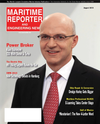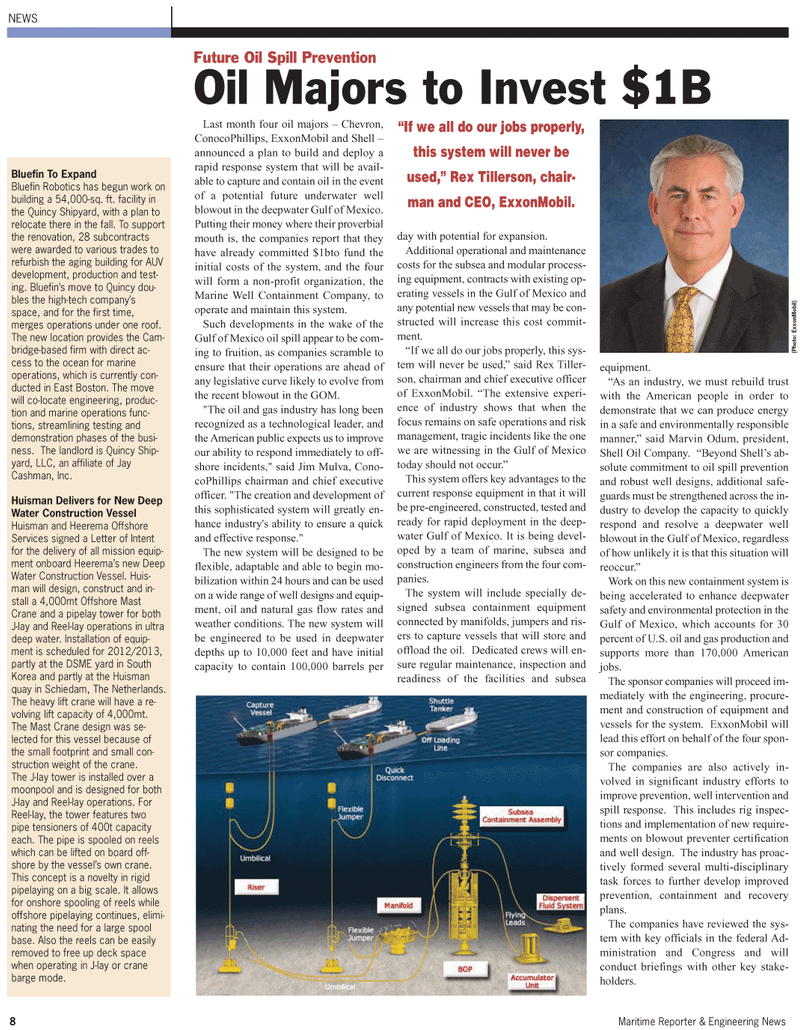
Page 8: of Maritime Reporter Magazine (August 2010)
The Electric Ship
Read this page in Pdf, Flash or Html5 edition of August 2010 Maritime Reporter Magazine
8 Maritime Reporter & Engineering News
NEWS
Bluefin To Expand
Bluefin Robotics has begun work on building a 54,000-sq. ft. facility in the Quincy Shipyard, with a plan to relocate there in the fall. To support the renovation, 28 subcontracts were awarded to various trades to refurbish the aging building for AUV development, production and test- ing. Bluefin’s move to Quincy dou- bles the high-tech company’s space, and for the first time, merges operations under one roof.
The new location provides the Cam- bridge-based firm with direct ac- cess to the ocean for marine operations, which is currently con- ducted in East Boston. The move will co-locate engineering, produc- tion and marine operations func- tions, streamlining testing and demonstration phases of the busi- ness. The landlord is Quincy Ship- yard, LLC, an affiliate of Jay
Cashman, Inc.
Huisman Delivers for New Deep
Water Construction Vessel
Huisman and Heerema Offshore
Services signed a Letter of Intent for the delivery of all mission equip- ment onboard Heerema’s new Deep
Water Construction Vessel. Huis- man will design, construct and in- stall a 4,000mt Offshore Mast
Crane and a pipelay tower for both
J-lay and Reel-lay operations in ultra deep water. Installation of equip- ment is scheduled for 2012/2013, partly at the DSME yard in South
Korea and partly at the Huisman quay in Schiedam, The Netherlands.
The heavy lift crane will have a re- volving lift capacity of 4,000mt.
The Mast Crane design was se- lected for this vessel because of the small footprint and small con- struction weight of the crane.
The J-lay tower is installed over a moonpool and is designed for both
J-lay and Reel-lay operations. For
Reel-lay, the tower features two pipe tensioners of 400t capacity each. The pipe is spooled on reels which can be lifted on board off- shore by the vessel’s own crane.
This concept is a novelty in rigid pipelaying on a big scale. It allows for onshore spooling of reels while offshore pipelaying continues, elimi- nating the need for a large spool base. Also the reels can be easily removed to free up deck space when operating in J-lay or crane barge mode.
Last month four oil majors – Chevron,
ConocoPhillips, ExxonMobil and Shell – announced a plan to build and deploy a rapid response system that will be avail- able to capture and contain oil in the event of a potential future underwater well blowout in the deepwater Gulf of Mexico.
Putting their money where their proverbial mouth is, the companies report that they have already committed $1bto fund the initial costs of the system, and the four will form a non-profit organization, the
Marine Well Containment Company, to operate and maintain this system.
Such developments in the wake of the
Gulf of Mexico oil spill appear to be com- ing to fruition, as companies scramble to ensure that their operations are ahead of any legislative curve likely to evolve from the recent blowout in the GOM. "The oil and gas industry has long been recognized as a technological leader, and the American public expects us to improve our ability to respond immediately to off- shore incidents," said Jim Mulva, Cono- coPhillips chairman and chief executive officer. "The creation and development of this sophisticated system will greatly en- hance industry's ability to ensure a quick and effective response."
The new system will be designed to be flexible, adaptable and able to begin mo- bilization within 24 hours and can be used on a wide range of well designs and equip- ment, oil and natural gas flow rates and weather conditions. The new system will be engineered to be used in deepwater depths up to 10,000 feet and have initial capacity to contain 100,000 barrels per day with potential for expansion.
Additional operational and maintenance costs for the subsea and modular process- ing equipment, contracts with existing op- erating vessels in the Gulf of Mexico and any potential new vessels that may be con- structed will increase this cost commit- ment. “If we all do our jobs properly, this sys- tem will never be used,” said Rex Tiller- son, chairman and chief executive officer of ExxonMobil. “The extensive experi- ence of industry shows that when the focus remains on safe operations and risk management, tragic incidents like the one we are witnessing in the Gulf of Mexico today should not occur.”
This system offers key advantages to the current response equipment in that it will be pre-engineered, constructed, tested and ready for rapid deployment in the deep- water Gulf of Mexico. It is being devel- oped by a team of marine, subsea and construction engineers from the four com- panies.
The system will include specially de- signed subsea containment equipment connected by manifolds, jumpers and ris- ers to capture vessels that will store and offload the oil. Dedicated crews will en- sure regular maintenance, inspection and readiness of the facilities and subsea equipment. “As an industry, we must rebuild trust with the American people in order to demonstrate that we can produce energy in a safe and environmentally responsible manner,” said Marvin Odum, president,
Shell Oil Company. “Beyond Shell’s ab- solute commitment to oil spill prevention and robust well designs, additional safe- guards must be strengthened across the in- dustry to develop the capacity to quickly respond and resolve a deepwater well blowout in the Gulf of Mexico, regardless of how unlikely it is that this situation will reoccur.”
Work on this new containment system is being accelerated to enhance deepwater safety and environmental protection in the
Gulf of Mexico, which accounts for 30 percent of U.S. oil and gas production and supports more than 170,000 American jobs.
The sponsor companies will proceed im- mediately with the engineering, procure- ment and construction of equipment and vessels for the system. ExxonMobil will lead this effort on behalf of the four spon- sor companies.
The companies are also actively in- volved in significant industry efforts to improve prevention, well intervention and spill response. This includes rig inspec- tions and implementation of new require- ments on blowout preventer certification and well design. The industry has proac- tively formed several multi-disciplinary task forces to further develop improved prevention, containment and recovery plans.
The companies have reviewed the sys- tem with key officials in the federal Ad- ministration and Congress and will conduct briefings with other key stake- holders. (Photo: ExxonMobil) “If we all do our jobs properly, this system will never be used,” Rex Tillerson, chair- man and CEO, ExxonMobil.
Future Oil Spill Prevention
Oil Majors to Invest $1B

 7
7

 9
9
